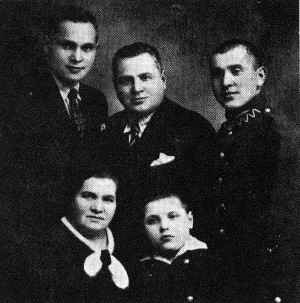|
I Will Remember
My Father Yehoshua Leib the son of Mordechai Shkolnik who died a natural death in his bed and was brought to his eternal rest in the cemetery in Swierzne on 28th Tishrei 1938
And all the members of my family will be remembered. Their fate was the fate of one third of our people who were annihilated by the German murderers and wiped off the earth.
My Mother Chaye-Sorre who was murdered in the great massacre of the Jews of Swierzneon 16th Cheshvan 5.11.1941
My sister Rivke-Leah with her husband and their four children
My sister Golda with her husband and their two children
My brother Mordechai with his wife and their two children
Altogether 23 souls, hardworking, innocent people, who lived a decent life, who were slaughtered for their only sin - for being Jewish.
I am the only one who remained from this extensive family, like a memorial candle in remembrance of a trunk that has been cut down.
I bow my head to their memory and I will not forget them until the end of my days.
May the Lord avenge their blood.
A.D. Shkolnik |

|
| |
Family Stoklitzki
Standing from the right: Sasha, Zecharyahu, Yitzhak
Sitting from the right: Avraham, Yentl,
“May the Lord avenge their blood”
|
|
|
The Days of Destruction and Struggle in Nove-Sverzsne
On the 27.6.1941, on the day that the Germans invaded the little town of Swierzne, the Jewish population of the town numbered 800 souls.
After two days - on the 29.6.1941 - the first victims fell, murdered by the Germans, they were: Reb Yosef Hertz Pertzovicz, his wife Leah and their son Yitzchak.
After 2 weeks the Gestapo organised a parade of the Jewish population of the town, on the town square next to the local council. After the degradation and the brutality meted
out to those gathered, four people were arrested: Yisroel Tselkovicz, Ben-Tsion Goldin and Liebson from Swierzne and Reb Aharon Vinshtin from Stoibtz. The first of those
mentioned was saved by a miracle and remained alive. The remaining three never returned.
Two days after Yom Kippur in the year 1941, Gestapo soldiers took out from amongst the Jews who were doing forced labour, cutting stone, twelve girls and eighteen men.
Among them was also the Rabbi of the place, Reb Chaim Avraham Alpert. They were all brought to the cemetery and murdered there.
On the 28.10.1941 the Jewish population of the town was gathered in the Ghetto. The Jews were concentrated in a few streets, the sides of the Ghetto included the Great
Synagogue. A high fence was erected around the Ghetto.
On the 4.11.1941 the Germans selected 120 Jews for hard labour from the Jewish population of Turtz and transferred them to Swierzne. On that same day the murderers destroyed those remaining in the town of Turtz.
The next day, on the 5.11.41, the murderers perpetrated the greatest massacre in Swierzne.
On that day more than 500 people were murdered, amongst them were those who were buried alive.
After the mass murder mentioned above, more than 300 people remained in the town of Swierzne - this included those who were transferred from Turtz. The Ghetto was
known as a “camp” and was called “Work Camp of Braslav-Moscow”. The SS Sergeant Beziller was appointed Commander of the camp.
On the 29.1.43, at 9 at night, about 1BO people escaped from the camp who had forgers amongst them. About 120 people remained in the camp and they were killed by the Gestapo two days after the escape.
Only 14 Jews remained who worked and lived in the vicinity of the lumber mill.
On the 8th of August they killed them too. Not one Jew remained in the town. The town of Swierzne remained “Juden Rein” - cleansed of Jews.
In the middle of the summer of 1944 when the Red Army captured the area, a few of its Jewish inhabitants that were in the forests and remained alive, returned to the town. After the war was over they all dispersed into the wide world in their search for a place to begin their lives anew. Most of them found their way to the State of Israel.
|
 Stowbtsy, Belarus
Stowbtsy, Belarus
 Yizkor Book Project
Yizkor Book Project
 JewishGen Home Page
JewishGen Home Page